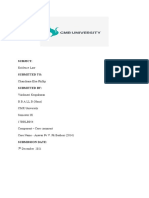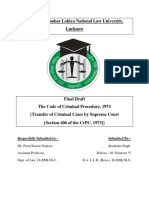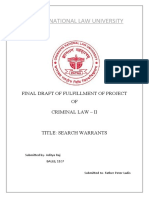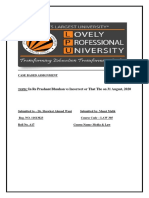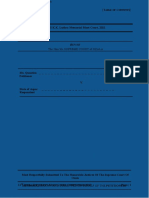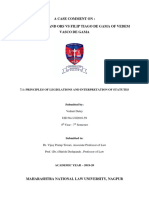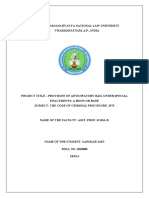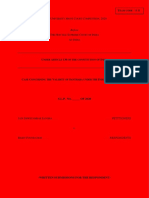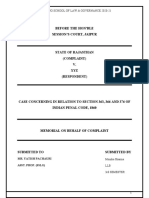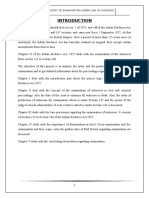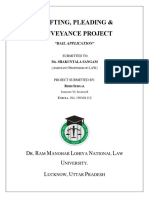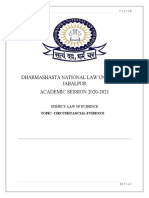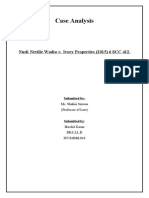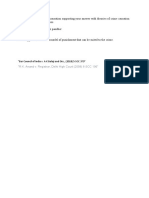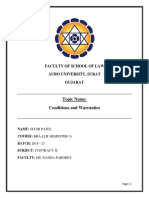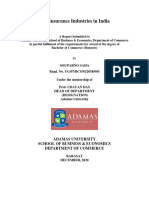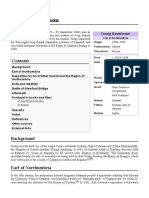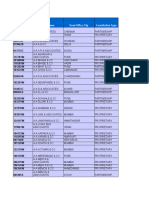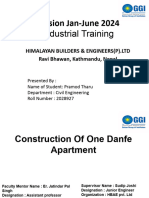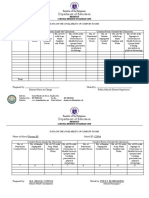School of Law
Module name: law of Evidence
ASSIGNMENT ON CASE ANALYSIS
CASE NAME:
RAM SINGH & ORS. V/S COL RAM SINGH
Submitted by:
Vinita Choudhary
BBA-LLB (2018- 2023)
Enrolment No.: 312018017
Vinita.choudhary.bballb18@aurouniversity.edu.in
Submitted to:
Ms. Vrushti Patel
Date of Submission:
25th April 2020, Saturday
1|Page
� In the supreme court of India
RAM SINGH & ORS. V/S COL RAM SINGH
Date of Decision: 07 August 1985
Citation: 1985 Lawsuit (SC) 24
Case brief:
• In the present case the general election to the State Assembly held in 1982 the appellants
and the respondents were the candidates.
• The respondent become declared elected to the Assembly. In their election petition, the
appellants alleged that the respondent was responsible of corrupt practice and booth
capturing in that he went to 2 polling booths alongside 50 to 60 persons, armed with
guns, sticks and swords, threatened and pressurized the voters and as a result of the critical
threats held out by way of the respondent and his guys the electorate ran away without
workout their franchise;
• that the respondent and his companions entered the polling cubicles and terrorized the
Polling Officer and polling retailers, assaulted the polling retailers at gun point, snatched
away the ballot papers and staining them in the respondent's favour, forged the votes in
the poll bins and thumb marked the counter foil of poll papers.
• They sought a assertion that the respondents election became void below phase a of under
section 100 the Representation of the People Act 1951. A large quantity of witnesses had
been tested with the aid of each facets.
• The Deputy Commissioner who became the Returning Officer of the constituency
recorded on a tape recorder the statements of identical individuals along with the polling
agents, the Polling Officer and the respondent and of himself.
2|Page
�Procedural history
The High Court held that the evidence of the witnesses and the petitioners on these points was
not corroborated, no effort was made by the petitioners to connect the respondent with the
ownership of vehicles purported to have been used by him, that the witnesses were drawing
more upon their imagination to make out stories about the detention of the persons and
forcible polling at that polling station by the respondent and that the 400 petitioners failed to
prove the charge beyond reasonable doubt. And The court also held that the role assigned to
the respondent by the petitioners has not been proved. So, the appeal is dismissing.
The appellants have failed to prove their case that the respondent was guilty of indulging in
corrupt practices. Clear and specific allegations with facts and figures regarding the corrupt
practices indulged in by the respondent have not been alleged in the first part of the election
petition. The petitioners should have given definitive and specific allegations regarding the
nature of fraud or the corrupt practices committed by the respondent as briefly as possible in
the main part of the petition. So, the appeal is dismissing.
Issues:
1. Whether value of tape-recording evidence will be considered as enough evidence for court
or not?
2. Whether Indian Evidence Act, 1872 detailed or described the importance, value, nature and
admissibility of such evidence in aspect of proving a person guilty?
Rules:
Code of Civil Procedure, 1908 Or8 R5
Evidence Act, 1872 Sec 6, Sec 61, Sec 67, Sec 7, Sec 8, Sec 3, Sec 65 B.
Representation of The People Act, 1951 Sec 116A, Sec 100, Sec 87, Sec 86, Sec 79(d), Sec
123, Sec 123(2), Sec 3
According to CIVIL PROCEDURE CODE, 1908 Order 8, Rule 5 SPECIFIC DENIAL Every
allegation of fact in the plaint, if not denied specifically or by necessary implication, or stated
3|Page
�to be not admitted in the pleading of the defendant, shall be taken to be admitted except as
against a person under disability. Provided that the Court may in its discretion require any fact
so admitted to be proved otherwise than by such admission. and According to Section- 03 of
Indian Evidence Act, 18721 defines Evidence as “All the statements which the court permits or
requires to be made before it by witnesses, in relation to matters of fact under inquiry;2 All the
documents including electronic records produced for the inspection of the court;3” which
means the definition clause of Evidence includes both a) evidence made by the witnesses- Oral
evidence and b) documentary evidence.
The word evidence is used in dissimilar senses, they are as follows:
a) As equivalent to evidence;
b) As equivalent to proof. And;
c) As equivalent to the material on the basis of which courts come to conclusion about the
existence or non-existence of disputed facts;4
according to Section 65A Special provisions as to evidence relating to electronic record The
contents of electronic records may be proved in accordance with the provisions of section 65B.
and Section 65B, Admissibility of electronic records 65B(1) Any information contained in an
electronic record which is printed on a paper, stored, recorded or copied in optical or magnetic
media produced by a computer (hereinafter referred to as the computer output) shall be deemed
to be also a document, if the conditions mentioned in this section are satisfied in relation to the
information and computer in question and shall be admissible in any proceedings, without
further proof or production of the original.
According to Section 123 REPRESENTATION OF THE PEOPLE ACT, 1950: Corrupt
practices : Undue influence, that is to say, any direct or indirect interference or attempt to
interfere on the part of the candidate or his agent, or of any other person [with the consent of
the candidate or his election agent], with the free exercise of any electoral right: Provided that
1
Section-03 of Indian Evidence Act, 1872, definition clause.
2
Such as Oral Evidence
3
Such as Documentary Evidence.
4
Kalyan Kumar Gogoi v. Ashutosh Agnihotri, AIR 2011 SC 760.
4|Page
�threatens any candidate or any elector, or any person in whom a candidate or an elector
interested, with injury of any kind including social ostracism and ex-communication or
expulsion from any caste or community. And Section 86 Trial of election petitions. —The High
Court shall dismiss an election petition which does not comply with the provisions of section
81 or section 82 or section 117. Explanation. —An order of the High Court dismissing an
election petition under this sub-section shall be deemed to be an order made under clause (a)
of section 98.
Applications:
Here in the present case the evidence in the present case consists of - a. Oral evidence of the
witnesses of the parties b. the documentary evidence c. the evidence consisting of the tape
recorded statements of the conversation between the Deputy Commissioner and the respondent,
Col. Ram Singh, corroborated by the respondent himself who was examined as a court witness
by us in this Court and both sides were given full opportunity to cross-examine him.
The nature of tape-recorded evidence will be judged by the circumstances of which such
evidence was submitted, if voice of the person was very clear, it can be substantive evidence.
Where in some other situations it can be primary evidence and such primary evidence is enough
to prove or to judge a person guilty in front of court of justice.5 Tape recorded conversation in
this case was held to be primary evidence and not secondary evidence which required
certificate under 65B6 . Understanding the relation between law and technology is not that easy,
however law always generated in favour of technology whenever it was found needed. There
is no limitation as respect to using of Tape-recording evidences in civil and criminal cases.
Under section 65A and 65B of IEA, 1872 Tape recording conversations can be accepted by the
court of justice in proving a person guilty; it can be submitted as primary evidence.
Admissibility of Tape-recorded conversation evidence: The law of evidence must be
adapted to realities of contemporary practice. The very admissibility of evidences in electronic
format has to fulfil conditions as mention in the 65B of Indian Evidence Act, 1872.
5
Ziyauddin Burhanuddin Bhukari v. Brijmohan Ramdas Mehta AIR 1975 SC 1788
6
VikramV. State of Punjab (2017) 8 SCC 518
5|Page
�In the present case Justice Fazal Ali with Justice Sabyasachi Mukherjee agreed to lay down
the following tests to determine admissibility of Tape-recorded conversations:
1) Accuracy of tape-recorded statement must be proved by the maker of the record by
satisfactory evidence.
2) Possibility of altering of any part of the tape-recorded statement must be excluded.
3) Tape recorded statement must be relevant.
4) Recorded cassettes must be sealed and must be in official custody.
5) Voice of particular speaker must be clearly audible and must not distorted by other sounds.
These are the 5 steps laid down by the Supreme Court in regarding to the aspect of submitting
Tape recorded conversation as evidence.
Where in the present case the sound was not clear and cassette was not kept in proper custody
after duly sealing the same and when the transcript of the tape recorded statement was being
prepared, recorder was absent, witnesses denied the statement, neither the tape shows where it
was recorded and when it was recorded etc. Tape recorded statements were wholly
inadmissible in the evidence.
Value of tape-recorded evidence will be considered as enough evidence when it was submitted
as primary evidence with a certain restriction laid down in a case7 that if tape recorded cassette
was not sealed or was not produced to the court immediately, and if transcription of the tape-
recorded conversation was also not produced then it cannot be considered as evidence. Source
and authenticity are the two major key factors for electronic evidence; if tape recorded
conversation is the only evidence to prove that any person accepting the bribe or demanding
the bribe it should be proved by following the steps/ procedure laid down in the present case
if such evidence was said audio is not clear or any other issue by the forensic department such
evidence will not be considered by the court.8
7
Lalji bansanarayan choubey v. jiyalal chavan, AIR 2009 (NOC) 1230 (BOM).
8
Sanjay singh Ramrao chavan v. dattatray gulabrao phalke (2015) 3 SCC 123 ( para 16)
6|Page
�However there exist many cases9 where the court of justice was completely relied upon the
electronic evidence submitted to the court. In similar case Supreme Court said that Provisions
of 65A are to be considered with provisions of 65B10 in aspect of any criminal contempt.
Order 8, Rule 5--Election Petition--Specific allegation in the petition that certain persons
involved in specific incident near a polling booth were relations of elected candidate.
No specific denial by the candidate in the written statement though it was a material fact--CPC
being applicable, in view of Order 8, Rule 5, candidate must be deemed to have admitted it.
Under Section 3 OF Indian evidence act Statement of a witness stating that he witnessed
altercation –between a voter and supporters of a candidate. He did not report to the Dupty
Commissioner or S.D.O. of ASI who visited subsequently to the spot and kept quite--Statement
cannot be relied upon.
Under Section 67 of Indian evidence act -Documentary evidence--Admissibility--Maker of the
complaint not examined--Documents containing complaint is clearly inadmissible. Witness
who is SDO relying in support of his testimony on complaint which was handed over to him
by the other witness--according to whom he merely handed over the complaint to the S D.O.
but the complaint did not bear his signature-maker the complaint not examined-r Admission
shows that contents of complaint were not proved. Complaint is clearly inadmissible, as a
person who hands over a complaint cannot be said to be the author of the same.
Under Sections 3 and 123 of representation of the people act, 1950 --Election Petition--
Allegations of corrupt practice—specific allegations with facts and figures regarding such
practice not mentioned in the main part of petition but in statement of petitioner only.
It is a relevant factor in Judging the truth of particulars mentioned in the Statement.
Clear and specific allegations of corrupt practice, with facts and figures regarding the corrupt
practice indulged in by the respondents not alleged in the first part of the petition itself, however
such allegations were detailed in the statement of particulars submitted by the appellants-Some
definite allegations should be mentioned in petition itself.
9
Anvar P.V. v. P.K. Basheer (2014) 10 SCC 473
10
Kamal Patel v. Ram Kishore Dogne
7|Page
�In the election petition it is alleged in relation to the incident at the Burthal Jat polling station
that Anil Kumar and Satbir Singh are the relatives of the respondent. There is no denial much
less any spefic denial of this allegation in the written statement of the respondent though it is a
material fact which ought to have been denied specifically if it was not admitted. Therefore,
under 0.8 r. 5 of the Code of Civil Procedure
Corrupt practice-Statement of a voter that he witnessed the alteration between the supporters
of a candidate and another voter near polling booth. But he did not report the matter to the
Deputy Commissioner or S.D.O. or ASI who had visited spot subsequently Evidence of such
witness.
In the other case the Court observed that the charge of a corrupt practice is in the nature of a
criminal charge which if proved, entails a very heavy penalty in the form of disqualification.
Therefore, a very cautious approach must be made in order to prove the charge of undue
influence levelled by the defeated candidate. It is for the party who sets up the plea of 'undue
influence' to prove it to the hilt beyond reasonable doubt and the manner of proof should be the
same as for an offence in a criminal case11. However, while insisting on standard of strict proof,
the Court should not extend or stretch this doctrine to such an extreme extent as to make it
well-nigh impossible to prove an allegation of corrupt practice.
Conclusion:
Three-Judge Bench considered the issue of the admissibility of the electronic evidence and held
that it will be wrong to deny to the law of evidence advantages to be gained by new techniques
and new devices, provided the accuracy of the recording can be proved. the respondent and
that the 400 petitioners failed to prove the charge beyond reasonable doubt. Such evidence
should always be regarded with some caution and assessed in the light of all the circumstances
of each case. Electronic evidence was held to be admissible subject to safeguards adopted by
the Court about the authenticity of the same. But in the present case the tape-recording evidence
the voice is not clear. In accordance with the decision of the majority, the appeal is dismissed
without any order as to costs. P.B.R.
11
Ram Sharan Yadav v. Thakur Muneshwar Nath Singh and Others [1984] S.C.C.
8|Page
�Case reference:
• Kalyan Kumar Gogoi v. Ashutosh Agnihotri, AIR 2011 SC 760.
• Ziyauddin Burhanuddin Bhukari v. Brijmohan Ramdas Mehta AIR 1975 SC 1788
• VikramV. State of Punjab (2017) 8 SCC 518
• Lalji bansanarayan choubey v. jiyalal chavan, AIR 2009 (NOC) 1230 (BOM).
• Sanjay singh Ramrao chavan v. dattatray gulabrao phalke (2015) 3 SCC 123
• Anvar P.V. v. P.K. Basheer (2014) 10 SCC 473
• Kamal Patel v. Ram Kishore Dogne
• Ram Sharan Yadav v. Thakur Muneshwar Nath Singh and Others [1984] S.C.C.
9|Page
�10 | P a g e
